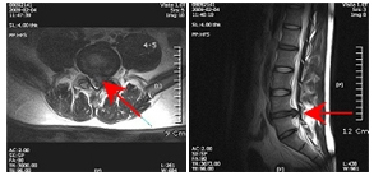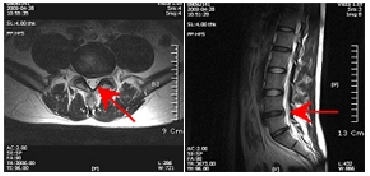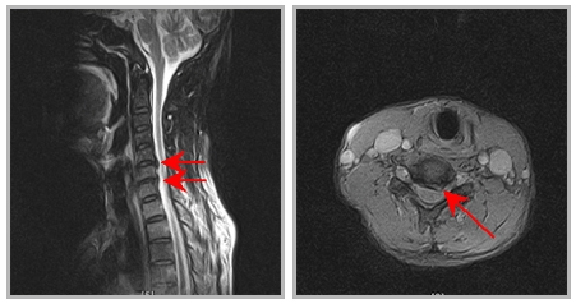
질환소개

Degenerated Disc- Herniated Lumbar Disc
Definition
Disck connects the upper and lower vertebral body to maintain the stability of the spine. This disease breaks out when the disc tissue ruptures and is pushed out to stimulate the nerve root or the dura mater of spinal cord.
Disck connects the upper and lower vertebral body to maintain the stability of the spine. This disease breaks out when the disc tissue ruptures and is pushed out to stimulate the nerve root or the dura mater of spinal cord.
Causes
- When the back was strained lifting something heavy
- Pain experienced from excessive exercise or work
- Stress placed on back due to bad posture or habits
- When the back was strained lifting something heavy
- Pain experienced from excessive exercise or work
- Stress placed on back due to bad posture or habits
Symptoms
- When the back was strained lifting something heavy
- Pain experienced from excessive exercise or work
- Stress placed on back due to bad posture or habits
- When the back was strained lifting something heavy
- Pain experienced from excessive exercise or work
- Stress placed on back due to bad posture or habits
| before | after |
|---|---|

|
 |
Treatments
- Non-surgical:
Medication, Physical Therapy (3D-Tracction), Spinal Injection
(extradural block method, selective nerve root injection )
- Surgical: Lumbar Microdiscetomy
- Non-surgical:
Medication, Physical Therapy (3D-Tracction), Spinal Injection
(extradural block method, selective nerve root injection )
- Surgical: Lumbar Microdiscetomy
Ruptured Cervical Disk
Definition
The disk that absorbs the shock between the cervical vertebral pressures the nerve passing the neck and occurs this disease.
The disk that absorbs the shock between the cervical vertebral pressures the nerve passing the neck and occurs this disease.
Cause
- Shock from a sudden external impact
- Bad posture or habits
- Occurs due to using high pillows
- Shock from a sudden external impact
- Bad posture or habits
- Occurs due to using high pillows
Symptoms
- Stiff back of the neck with pain experienced, and tingling sensation or pain at shoulder, arm, or hand
- Weaker grip when writing or grabbing objects, and abnormal sensation at the finger area
- If left untreated, paralysis at lower body or the whole body can occur
- Stiff back of the neck with pain experienced, and tingling sensation or pain at shoulder, arm, or hand
- Weaker grip when writing or grabbing objects, and abnormal sensation at the finger area
- If left untreated, paralysis at lower body or the whole body can occur
| 5-6, 6-7 Disk |
|---|

|
Treatments
- Non-Surgical :
Medication, Physical Therapy (3D-Tracction) Spinal Injection(extradural block method, selective nerve root injection)
- Surgical: Lumbar Microdiscetomy
- Non-Surgical :
Medication, Physical Therapy (3D-Tracction) Spinal Injection(extradural block method, selective nerve root injection)
- Surgical: Lumbar Microdiscetomy
Spinal Canal Stenosis
Definition
Spinal canal is a canal that the spinal cord goes through from brain to legs and arms. When something happens to narrow the spinal canal in the middle of the spine, nerve root, or the intervertedvral foramen, it brings out back pain or various complex nerve symptoms. It is called the Spinal Canal Stenosis.
Spinal canal is a canal that the spinal cord goes through from brain to legs and arms. When something happens to narrow the spinal canal in the middle of the spine, nerve root, or the intervertedvral foramen, it brings out back pain or various complex nerve symptoms. It is called the Spinal Canal Stenosis.
Cause
- In case of a congenital narrow lumbar, the time the person turns his/her 30’s when the degenerating changes starts, the change of the bone and tendon overlaps amd the disease breaks out. The spinal degeneration ostarthritis makes the tendon and joints thick and the disk gets projected, cramping the space of the nerve and there for this disease occurs.
- Spondylolisthesis, Post-surgery Complications, abnormal adhesion after fracture, etc.
- In case of a congenital narrow lumbar, the time the person turns his/her 30’s when the degenerating changes starts, the change of the bone and tendon overlaps amd the disease breaks out. The spinal degeneration ostarthritis makes the tendon and joints thick and the disk gets projected, cramping the space of the nerve and there for this disease occurs.
- Spondylolisthesis, Post-surgery Complications, abnormal adhesion after fracture, etc.
Symptoms
- Confused due to similar symptoms as disc
- Repeated occurrence of pain in the leg while walking, and symptoms improve when rested
- Cannot straighten out the back while sleeping, and the patient ends up curling
- Confused due to similar symptoms as disc
- Repeated occurrence of pain in the leg while walking, and symptoms improve when rested
- Cannot straighten out the back while sleeping, and the patient ends up curling
| 4~5 lumbar Spinal Canal Stenosis |
|---|

|
Treatments
- Non-Surgical :
Stabilization and Exercise, Subsidiaries, Physical Therapy, Spinal Injection Therapy
- Surgical: Decompression, Vertebral Body Adhesion Operation
- Non-Surgical :
Stabilization and Exercise, Subsidiaries, Physical Therapy, Spinal Injection Therapy
- Surgical: Decompression, Vertebral Body Adhesion Operation
Epidural Leakage
Definition
This can often happen especially to osteoporosis patients, people of old age, or women going through menopause. The disease occurs when the spine bone crushes and flattened by a strong shock or an external injury.
This can often happen especially to osteoporosis patients, people of old age, or women going through menopause. The disease occurs when the spine bone crushes and flattened by a strong shock or an external injury.
Cause
- Occurs by a light external injury in case of osteoporosis
- External shock
- Unbalanced nutrition, due to bad eating habit
- Women going through menapause. With low bone density, the bone can be weak.
- Occurs by a light external injury in case of osteoporosis
- External shock
- Unbalanced nutrition, due to bad eating habit
- Women going through menapause. With low bone density, the bone can be weak.
Symptoms
- Uneasy to move, painful when getting up or walking
- No specific symptom with the bone fracture, but as the fracture gets serious the pain reveals itself.
- Backache when moving lying down.
- Weak back, the body bends forward.
- Severe back pain that makes it hard to breathe.
- Uneasy to move, painful when getting up or walking
- No specific symptom with the bone fracture, but as the fracture gets serious the pain reveals itself.
- Backache when moving lying down.
- Weak back, the body bends forward.
- Severe back pain that makes it hard to breathe.
| Epidural Leakage |
|---|

|
Treatments
- Non-Surgical : Wear subsidiaries. Control stabilization and pain.
- Surgical: : Percutaneous vertebroplasty, Kyphoplasty
- Non-Surgical : Wear subsidiaries. Control stabilization and pain.
- Surgical: : Percutaneous vertebroplasty, Kyphoplasty
Cervical Vertebral Stenosis
Definition
This can be confused with a neck disk; it occurs when the cervical vertebral gets narrowed by various causes which pushes down the nerve and brings pain.
This can be confused with a neck disk; it occurs when the cervical vertebral gets narrowed by various causes which pushes down the nerve and brings pain.
Cause
- Congenitally narrow cervical vertebral
- Bad habit of pulling and pushing down the neck
- Degenerational changes
- Congenitally narrow cervical vertebral
- Bad habit of pulling and pushing down the neck
- Degenerational changes
Symptom
- No direct pain, slowly progresses
- Pain in neck, shoulders, and arms
- Numb or hurtful hands-motor ability decreases
- No direct pain, slowly progresses
- Pain in neck, shoulders, and arms
- Numb or hurtful hands-motor ability decreases
Treatments
- Non-Surgical:
Medication, Extracorporeal Shock Wave Therapy, Nerve Block Method, Epidural Neuroplasty, High-Frequncy Disk
- Surgical : Cervical Vertebrae Canal Expansionplasty, Spinal Fusion
- Non-Surgical:
Medication, Extracorporeal Shock Wave Therapy, Nerve Block Method, Epidural Neuroplasty, High-Frequncy Disk
- Surgical : Cervical Vertebrae Canal Expansionplasty, Spinal Fusion


















